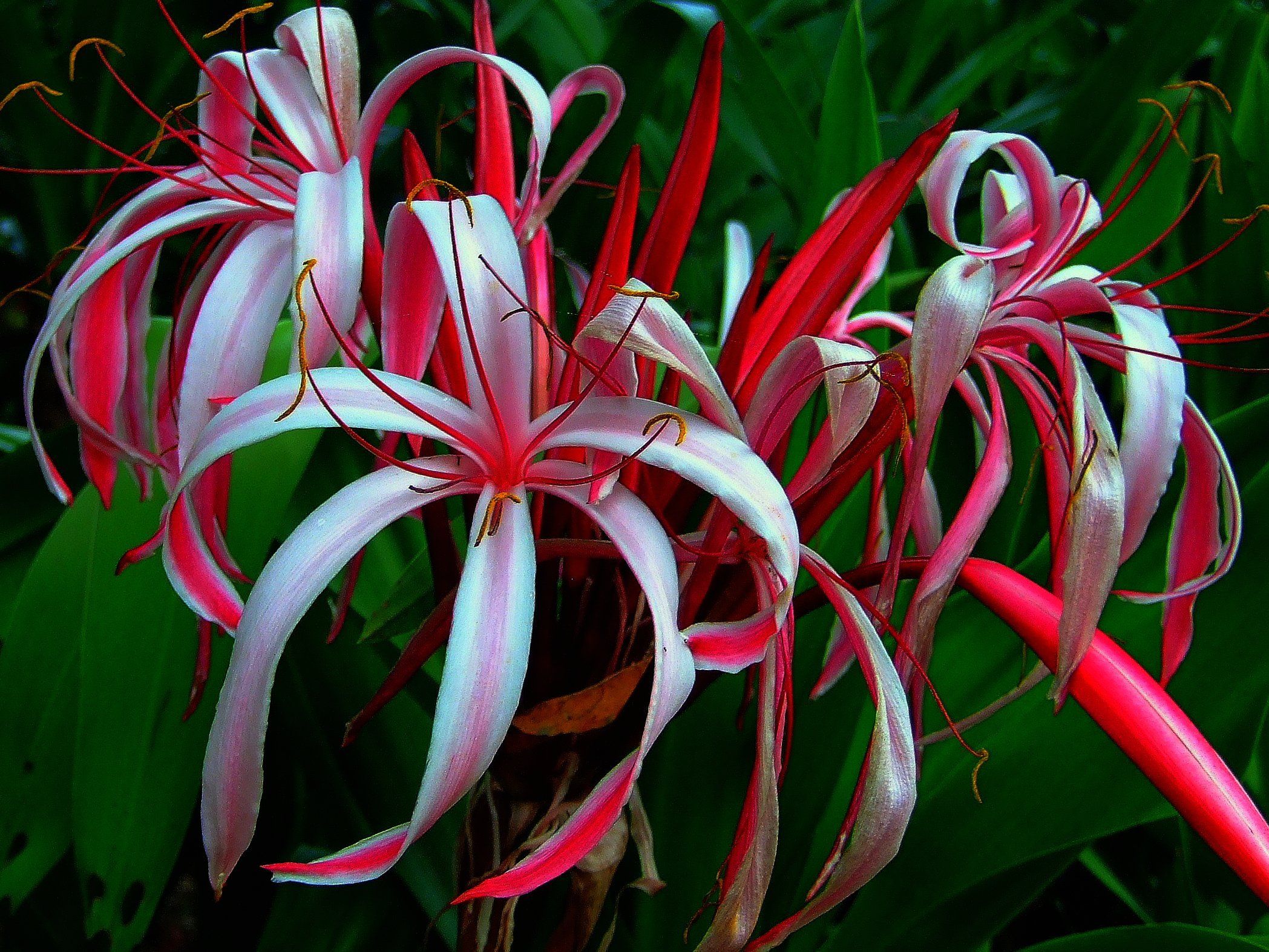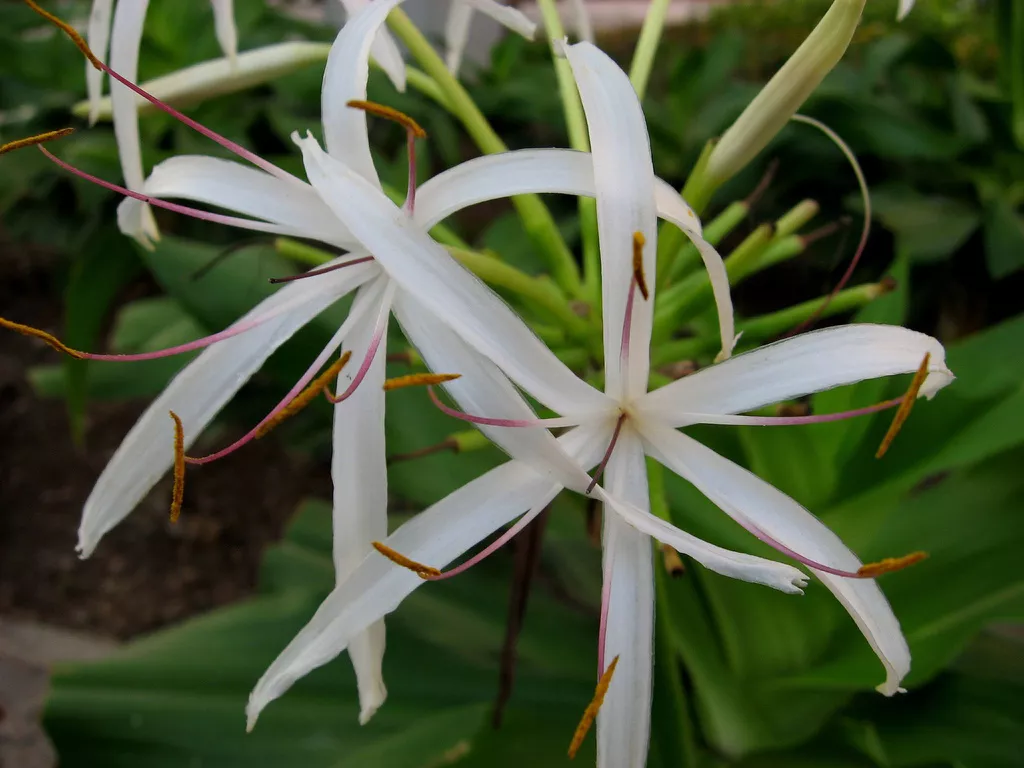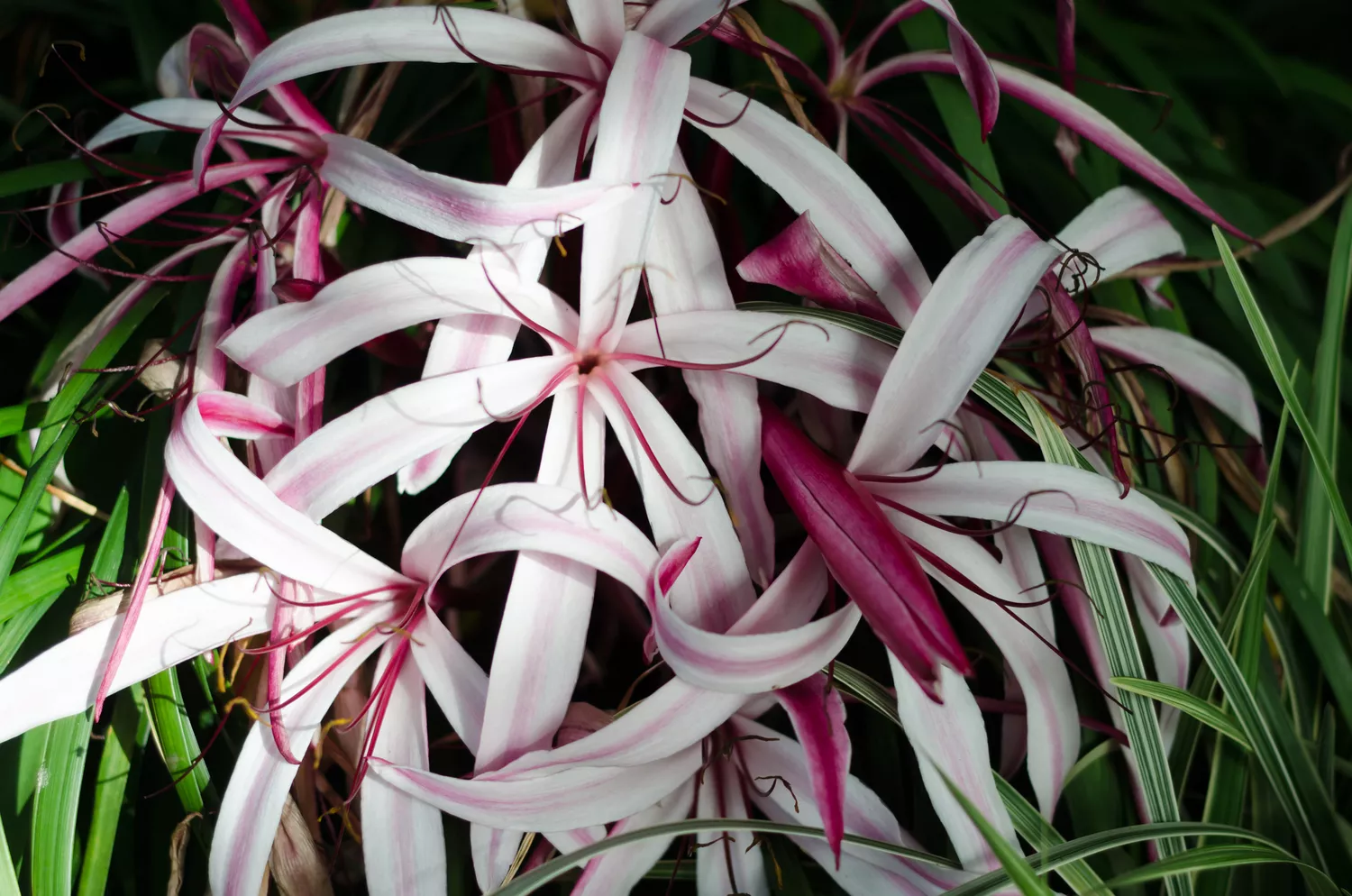Plant Attributes

| Common name | Crinum lily, poison bulb, spider lily, grand crinum lily |
| Botanical name | Crinum asiaticum |
| Family | Amaryllidaceae |
| Plant type | Perennial bulb |
| Mature size | 4-6 feet tall, same size spread |
| Sun exposure | Full sun to partial shade |
| Soil type | Well-draining, moist soil, organic-rich |
| Soil pH | 5.0 – 8.0 |
| Bloom time | Summer |
| Flower color | White, sometimes marked with pink |
| Hardiness zone | 7 to 11 |
| Native area | Asia, Australia, Africa, and the Americas |
| Toxicity | All parts of this plant are poisonous |

How To Care For Crinum Lilies
Crinum lilies are summer-flowering perennials that adapt well and grow easily in soggy or dry soil. Their easygoing nature makes them simple to care for, and while they have been known to thrive indefinitely, they are not winter-hardy. They may die back during cold winters, but their underground bulbs help them come back to life in the warmer season. For colder climates, consider growing the planting in containers that can be dug up and brought indoors for overwintering.
Light
Crinum Lily loves the sun. But it’ll accept partial shade, particularly during the hottest part of the day. It can develop leaf scorch if the intensity of the sun is particularly intense.
Most people will find that six to eight hours of sunlight is perfect for optimal growth. If you’re in a sweltering climate, consider four to six hours of direct sun and a few hours of partial shade.
Soil
Your ideal soil for your crinum lily should be moist but well-draining. It should be rich with organic matter and fertile. While this plant can grow in poor soils as well, it will be vigorous with this mix.
Water
Crinum lilies perform best in locations that get consistent watering. Pond borders and poolside placements are common. But don’t limit them to those areas. If you water regularly, you can place these throughout your yard.
While the crinum lily can tolerate infrequent watering, they won’t grow as fast. Short periods of drought are okay, as long as they don’t last more than a few days to a week at most. These may need more water during the hottest times of the year.
If there are puddles or the ground is muddy, wait for the water to drain away and the soil to partially dry. Excess water can cause the bulb to develop rot issues.
Temperature And Humidity
In cooler climates, this plant should be brought indoors before cooler weather arrives. Once the temperature dips below 40ºF at night, you run the risk of the leaves becoming cold-damaged. These plants are not frost-hardy at all, and the first frost often causes dieback of foliage.

Fertilizer
Consider a slow-release, balanced granular fertilizer. Spread this in early spring, early summer, and early fall around the base of plants. Work it lightly into the soil. This should be plenty of food for your plants.
If you’d prefer a liquid, opt for a half-strength liquid fertilizer. From spring through the summer, fertilize monthly. Only fertilize it once early in the fall, and skip the winter entirely.
Propagating
Crinum lilies have a long tradition in the Southern U.S. as a pass-along flower owing much to their resilience when dividing the offsets. You can dig and divide the bulbs when starting, or in full growth. The clumps and individual bulbs can get rather large, so digging and dividing the outermost bulbs of the clump is recommended unless you have access to a backhoe.
Potting And Repotting Crinum Lilies
Crinums tolerate many soils, from wet to well-drained to dry (although blooming is often spurred by spring and summer downpours). Many crinums grow into large clumps of absolutely enormous bulbs that store food reserves.
This means that can they weather long stretches of drought and utter neglect and then bloom when conditions improve. It also means that, unlike most plants, you can dig, transplant, share (and ship) crinums just about any time without killing them.
Overwintering
Prepare your plant for overwintering if you live in USDA Zones 8 or 9. If you do not regularly get frosts and freezers, you may be able to simply trim back the leaves as the weather cools and add extra mulch to protect the bulb. However, if your area experiences frequent below-freezing temperatures, consider moving the plant indoors as the plant is not tolerant of hard freezes. To move your plant indoors, uproot the bulb and put the plant in a pot slightly bigger than the bulb. Add soil, and keep it indoors with ample light through the coldest months of the year. You can also remove the outermost leaves on bulbs to avoid the plant taking up too much space.
Removing the outermost leaves on bulbs that are moved indoors can be really helpful. This prevents the plant from taking up an excess of space.

Common Pests And Plant Diseases
Some types of grasshoppers, especially the eastern lubber grasshopper, can become a problem. These hungry little pests will devour the leaves of your plant. To combat these, use a bacillus thurigiensis spray or powder. The grasshoppers won’t survive.
Some types of mealybugs find crinum lily to be appetizing. A good spraying of neem oil makes for a deterrent. An insecticidal soap may also be useful if they are persistent.
Nematodes, particularly root-knot nematodes, may become a problem. Use beneficial nematodes to counteract these bad forms. The beneficial ones will protect your plants from a host of other problems, too.
Finally, those long leaves are appealing to both slugs and snails. Not only do they provide daytime cover that the slimies can hide in, but they taste good too. Apply an organic slug and snail bait around your plants to lure them out and kill them off.
How To Get Crinum Lilies To Bloom
Crinums grow best in warmer USDA Zones, including USDA Zones 7-11. However, there are some crinums that can survive frigid winters. The hardiest, Crinum bulbispermum, shown below, is fully hardy in USDA Zone 6A, and is reported to have survived -20ºF. It is prudent to plant them 18 inches deep in this zone, however.

Elsewhere, choose a sunny spot with decent soil for planting. Find the area where the plant’s color transitions from white to green known as the neckline of the bulb. Use the neckline to help determine the depth of your hole; the hole you dig should be six inches deeper than the neckline. Place the bulb at the bottom of the hole and cover it with soil.
Common Problems With Crinum Lilies
As I mentioned above, plants in hot, full-sun conditions can experience leaf scorch. While not common, it does happen when the temperature peaks mid-to-late summer. If you have a large plant, a few scorched leaves won’t cause you any harm. But if it’s young, this may be a problem. Try to place your plants where there’s afternoon shade if you’re in a hot climate.
If overwatered, you may find the bulbs start to rot. They’re tolerant of excess water to a point, but eventually will succumb. Ensure your soil is well-draining to prevent this problem by adding sand or perlite.
If the tips of the leaves are starting to go brown, this is usually a sign of too little water. Be sure the moisture in your soil is consistent. Mulching around your plants can help keep the soil moist for longer periods of time.





